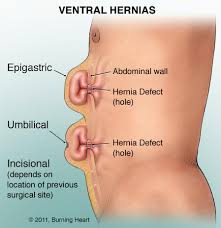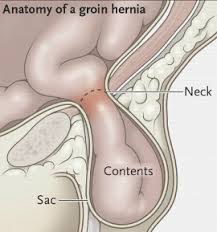A hernia occurs when an organ pushes through an opening in the muscle or tissue that holds it in place. For example, the intestines may break through a weakened area in the abdominal wall.
Hernias are most common in the abdomen, but they can also appear in the upper thigh, belly button, and groin areas. Most hernias are not immediately life threatening, but they don’t go away on their own and can require surgery to prevent potentially dangerous complications.
What Is a Hernia?
Definition 2-A hernia occurs when an organ or fatty tissue squeezes through a weak spot in a surrounding muscle or connective tissue called fascia. The most common types of hernia are inguinal (inner groin), incisional (resulting from an incision), femoral (outer groin), umbilical (belly button), and hiatal (upper stomach).

What are the different types of hernia?
The most common types of hernia are inguinal (inner groin), incisional (resulting from an incision), femoral (outer groin), umbilical (belly button), and hiatal (upper stomach). In an inguinal hernia, the intestine or the bladder protrudes through the abdominal wall or into the inguinal canal in the groin.In an inguinal hernia, the intestine or the bladder protrudes through the abdominal wall or into the inguinal canal in the groin. About 96% of all groin hernias are inguinal, and most occur in men because of a naturalweakness in this area.
In an incisional hernia, the intestine pushes through the abdominal wall at the site of previous abdominal surgery. This type is most common in elderly or overweight people who are inactive after abdominal surgery.
A femoral hernia occurs when the intestine enters the canal carrying the femoral artery into the upper thigh. Femoral hernias are most common in women, especially those who are pregnant or obese.
In an umbilical hernia, part of the small intestine passes through the abdominal wall near the navel. Common in newborns, it also commonly afflicts obese women or those who have had many children.
A hiatal herniahappens when the upper stomach squeezes through the hiatus, an opening in the diaphragm through which the esophaguspasses.
Inguinal Hernia
Inguinal hernias are the most common type of hernia. They make up about 70 percent of all hernias, according to theBritish Hernia Centre (BHC). These hernias occur when the intestines push through a weak spot or tear in the lower abdominal wall, often in the inguinal canal.
The inguinal canal is found in your groin. In men, it is the area where the spermatic cord passes from the abdomen to the scrotum. This cord holds up the testicles. In women, the inguinal canal contains a ligament that helps hold the uterus in place.
This type of hernia is more common in men than in women. This is because a man’s testicles descend through the inguinal canal shortly after birth, and the canal is supposed to close almost completely behind them. Sometimes, the canal does not close properly and leaves a weakened area prone to hernias.
Hiatal Hernia
A hiatal hernia occurs when part of your stomach protrudes up through the diaphragm into your chest. The diaphragm is a sheet of muscle that helps you breathe by contracting and drawing air into the lungs. It separates the organs in your abdomen from those in your chest.
This type of hernia is most common in patients over 50 years old. If a child has the condition, it’s typically caused by a congenital (birth) defect. Hiatal hernias almost always cause gastroesophageal reflux, which is when the stomach contents leak backward into the esophagus, causing a burning sensation.
Umbilical Hernia
Umbilical hernias can occur in children and babies under 6 months old. This happens when their intestines bulge through their abdominal wall near their bellybutton. You may notice a bulge in or near your child’s bellybutton, especially when they’re crying.
An umbilical hernia is the only kind that often goes away on its own, typically by the time the child is 1 year old. If the hernia has not gone away by this point, surgery may be used to correct it. Other type
Incisional Hernia
Incisional hernias can occur after you’ve had abdominal surgery. Your intestines may push through the incision scar or the surrounding, weakened tissue.
- Epigastric hernias – these occur when fatty tissue pokes through your abdomen, between your navel and the lower part of your breastbone (sternum).
- Spigelian hernias – these occur when part of your bowel pokes through your abdomen at the side of your abdominal muscle, below your navel.
- Diaphragmatic hernias – these occur when organs in your abdomen move into your chest through an opening in the diaphragm. This can affect babies if their diaphragm does not develop properly in the womb, but can also affect adults.
- Muscle hernias – these occur when part of a muscle pokes through your abdomen. They can also occur in leg muscles as the result of asports injury.
What Causes a Hernia?Hernias are caused by a combination of muscle weakness and strain. Depending on its cause, a hernia can develop quickly or over a long period of time.
Common causes of muscle weakness include:
- failure of the abdominal wall to close properly in the womb, which is a congenital defect
- age
- chronic coughing
- damage from injury or surgery
Factors that strain your body and may cause a hernia, especially if your muscles are weak, include:
- being pregnant, which puts pressure on your abdomen)
- being constipated, which causes you to strain when having a bowel movement
- heavy weight lifting
- fluid in the abdomen, or ascites
- suddenly gaining weight
- persistent coughing or sneezing
Risk for a Hernia?The factors that increase your risk of developing a hernia include:
- a personal or family history of hernias
- being overweight or obese
- a chronic cough
- chronic constipation
- smoking, which can trigger a chronic coughUltimately, all hernias are caused by a combination of pressure and an opening or weakness of muscle or fascia; the pressure pushes an organ or tissue through the opening or weak spot. Sometimes the muscle weakness is present at birth; more often, it occurs later in life.
Anything that causes an increase in pressure in the abdomen can cause a hernia, including:
In addition, obesity, poor nutrition, and smoking, can all weaken muscles and make hernias more likely.
Conditions such as cystic fibrosis can also indirectly increase your risk of developing a hernia. Cystic fibrosis impairs the function of the lungs, causing a chronic cough.
What Are the Symptoms of a Hernia?The most common symptom of a hernia is a bulge or lump in the affected area. In the case of an inguinal hernia, you may notice a lump on either side of your pubic bone where your groin and thigh meet. You’re more likely to feel your hernia through touch when you’re standing up.
If your baby has a hernia, you may only be able to feel the bulge when he or she is crying. A bulge is typically the only symptom of an umbilical hernia.
Other common symptoms of an inguinal hernia include:
- pain or discomfort in the affected area (usually the lower abdomen), especially when bending over, coughing, or lifting
- weakness, pressure, or a feeling of heaviness in the abdomen
- a burning, gurgling, or aching sensation at the site of the bulge
Other symptoms of a hiatal hernia include:
- acid reflux, which is when stomach acid moves backward into the esophagus causing a burning sensation
- chest pain
- difficulty swallowing
In some cases, hernias have no symptoms. You may not know you have a hernia unless it shows up during a routine physical or a medical exam for an unrelated problem.
How Is a Hernia Diagnosed?Inguinal or incisional hernias are usually diagnosed through a physical examination. Your doctor may feel for a bulge in your abdomen or groin that gets larger when you stand, cough, or strain.
If you have a hiatal hernia, your doctor may diagnosed it with a barium X-ray or endoscopy. These tests allow your doctor to see the internal location of your stomach:
- A barium X-ray is a series of X-ray pictures of your digestive tract. The pictures are recorded after you’ve finished drinking a liquid solution containing barium, which shows up well on the X-ray images.
- An endoscopy involves threading a small camera attached to a tube down your throat and into your esophagus and stomach.
If your child has an umbilical hernia, your doctor may perform an ultrasound. An ultrasound uses high-frequency sound waves to create an image of the structures inside the body
When to seek medical advice
You should see your GP if you think you have a hernia, so they can determine whether you need to be referred for surgical treatment.
You should go the accident and emergency (A&E) department of your nearest hospital immediately if you have a hernia and you develop any of the following symptoms:
- sudden, severe pain
- vomiting
- difficulty passing stools (constipation) or wind
- the hernia becomes firm or tender, or cannot be pushed back in
These symptoms could mean that the blood supply to a section of organ or tissue trapped in the hernia has become cut off (strangulation), or that a piece of bowel has entered the hernia and become blocked (obstruction).
A strangulated hernia and obstructed bowel are medical emergencies and need to be treated as soon as possible.
Assessing hernias
Your GP will usually be able to identify a hernia by examining the affected area.
In some cases, they may decide to refer you to a nearby hospital to have an ultrasound scan to confirm the diagnosis or assess the extent of the problem. This is a painless scan where high-frequency sound waves are used to create an image of part of the inside of the body.
Once a diagnosis has been confirmed, your GP or hospital doctor will determine whether surgery to repair the hernia is necessary.
A number of factors will need to be taken into consideration when deciding whether surgery is appropriate, including
- The type of hernia – some types of hernia are more likely to become strangulated, or cause a bowel obstruction, than others.
- The content of your hernia – if the hernia contains a part of your bowel, muscle or other tissue, there may be a risk of strangulation or obstruction.
- Your symptoms and the impact on your daily life – surgery may be recommended if your symptoms are severe or getting worse, or if the hernia is affecting your ability to carry out your normal activities.
- Your general health – surgery may be too much of a risk if your general health is poor.
Although most hernias will not get better without surgery, they will not necessarily get worse. In some cases, the risks of surgery will outweigh the potential benefits.






